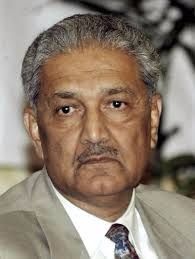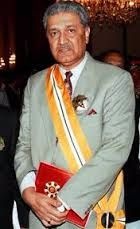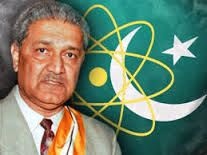 Abdul Qadeer Khan:(Urdu: ڈاکٹر عبد القدیر خان; b. 1 April 1936), and known widely as A. Q. Khan, is a Pakistani nuclear physicist and a metallurgical engineer, and the founder of the uranium enrichment program for Pakistan's atomic bomb project. Khan founded and established theKahuta Research Laboratories (KRL) in 1976, serving as both its senior scientist and Director-General until his retirement in 2001. Khan was also an early and vital figure in other Pakistani national science projects, making major contributions in research on molecular morphology, the physics of martensite alloys, condensed matter physics and materials physics.
Abdul Qadeer Khan:(Urdu: ڈاکٹر عبد القدیر خان; b. 1 April 1936), and known widely as A. Q. Khan, is a Pakistani nuclear physicist and a metallurgical engineer, and the founder of the uranium enrichment program for Pakistan's atomic bomb project. Khan founded and established theKahuta Research Laboratories (KRL) in 1976, serving as both its senior scientist and Director-General until his retirement in 2001. Khan was also an early and vital figure in other Pakistani national science projects, making major contributions in research on molecular morphology, the physics of martensite alloys, condensed matter physics and materials physics.
In January 2004, Dr. Khan was summoned by the Pakistani government for a debriefing on his active role in proliferating nuclear weapons technology to other countries after the United States provided evidence of these activities to the Pakistan Government. Khan formally admitted his responsibility for the acitvities in question a month later. It is alleged that Khan's activities were sanctioned by Pakistani authorities. The Pakistan government has sharply dismissed these claims.
After years of official house arrest during and following his debriefing, the Islamabad High Court (IHC) on 6 February 2009 declared Abdul Qadeer Khan to be a free citizen of Pakistan, allowing him free movement inside the country. The verdict was rendered by Chief Justice Sardar Muhammad Aslam. In September 2009, expressing concerns over the Islamabad High Court's decision to end all security restrictions on Khan, the United States warned that Khan still remains a "serious proliferation risk".
Early life
Khan was born in 1936 in Bhopal, a princely state within the British Indian Empire, into an Urdu-speaking family who claimed to be originally ethnic Pashtuns.His mother, Zulekha Begum, was a housewife; his father, Abdul Ghafoor, an administrator, was a member of a family of Shaikh Hindu converts who adopted the title or surname of Khan and claimed to be of Pashtun origins.
He was an alumnus of Nagpur University and an academic who served in the British Indian Education ministry and settled with his family in Bhopal State after his retirement in 1935.[12] In 1952, some years after the violent partition of India in 1947, the family emigrated from India to Pakistan and settled in Karachi, Sindh.[9]Briefly attending the D.J. Science College, the young Khan enrolled in Karachi University in 1956 to study physics.[13][14] In 1960, he graduated with degree inphysics with minor in mathematics, where his degree concentration was in solid-state physics.[15]
For a short time, Khan worked for the Karachi Metropolitan Corporation as an inspector of weights and measures.In 1961, he went to Germany to studymetallurgy at the Technical University in Berlin (TU Berlin) but made a transfer to Delft University of Technology in the Netherlands in 1965. At Delft, he obtained an engineer's degree in technology (an equivalent to MS) in 1967 and joined the Catholic University of Leuven for his doctoral studies.Supervised by Dr. Martin Brabers at Leuven, Khan received a D.Eng. degree in metallurgical engineering in 1972. His doctoral thesis dealt with and contained fundamental work on copper-based martensite and its extended industrial applications in the field of morphology— a field that studies the shape, size, texture, and phase distribution of physical objects.
Research in Europe

Receiving his doctorate engineering in 1972, Khan joined the senior staff of the Physics Dynamics Research Laboratory in Amsterdam from a recommendation by his mentor, Martin J. Brabers. His initial studies were on the high-strength metals used in the development of centrifuges.Gas centrifuges were first conceived by American physicist Jesse Beams as part of the Manhattan Project but the studies were discontinued in 1944.The Physics Laboratory was a subcontractor forUrenco Group which was operating a uranium-enrichment plant in Almelo, Netherlands.Established in 1970, Urenco employed the centrifuge method to assure a supply of enriched uranium for nuclear power plants in the Netherlands. When Urenco offered him to join the senior scientific staff there, Khan left the Physics Laboratory where he performed physics experiments on uranium metallurgy, to produce reactor-grade uranium usable for light water reactors. Urenco used the Zippe-type gas centrifuges— a method invented by German mechanical engineer Gernot Zippe in the Soviet Union's program. Enrichment of uranium is an extremely difficult physical process, as U235 exists in natural uranium at a concentration of only 0.7%; Urenco used the Zippe method to separate the fissile isotopesU235 from non-fissile U238 by spinning UF6 gas at up to ~100,000RPM. His pioneering research led to the improvement of the Zippe method, which at that time, was an emerging technology whose publications were classified by the Soviet Union. Khan's leading-edge research in metallurgy brought laurels to Urenco, which had him as one of the most senior scientists at the facility where he researched and studied.His pioneering research greatly improved the technologicalefficiency of the Zippe method; eventually, Urenco gave Khan access to the blueprints for the Zippe centrifuge to find mathematical solutions for the physics problems in the gas centrifuges.
1971 war and return to Pakistan

On 20 January 1972, President Zulfikar Ali Bhutto approved a crash program to develop an atomic bomb after chairing a winter seminar – the Multan meeting – with the academic scientists at Multan.Directly under President Bhutto, this crash program ran under Munir Ahmad Khan, the chairman of the Pakistan Atomic Energy Commission (PAEC), as the outcomes of the 1971 war with its eastern part, where India, also involved as opponent, had put Pakistan's strategic position in great danger. Earlier efforts were towards the development of the implosion-type bomb utilizing military-grade plutonium.Prior to 1974, Khan had no advance knowledge of the crash program– a controversy which calls into question Abdul Qadeer Khan's "father-of" claim.Following India's surprise "Smiling Buddha" in 1974, Prime Minister Bhutto accelerated Pakistan's efforts to attain a atomic capability. Sensing the importance of the test, Munir Ahmad launched the secretiveProject-706.
After learning about the nuclear test, Khan wanted contribute to the post-war military posture; hence approaching to Pakistan government officials who dissuaded him by considering as "hard to find" a job in PAEC as a "metallurgist".
Undaunted, he wrote to Prime minister Bhutto, highlighting his specific experience and encouraged Prime Minister Bhutto to work on an atomic bomb using military-grade uranium.According to Kuldip Nayyar, although the letter was received by Prime minister Secretariat, Khan was still unknown to the Pakistan government, leading Bhutto to ask the ISI to run a complete background check on Khan and prepare an assessment report on him.The ISI considered as him "incompetent" but Bhutto was unsatisfied and eager to know more about him, eventually asking Munir Ahmad to dispatch a PAEC team to meet him.The PAEC team includingBashiruddin Mahmood arrived at the Almelo at his family home at night. After an interview, the team returned to Pakistan and Prime Minister Bhutto decided to meet with Khan, and directed a confidential letter to him. Soon after, Khan took a leave from Urenco, and departed for Pakistan in 1974.



